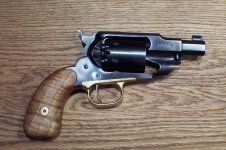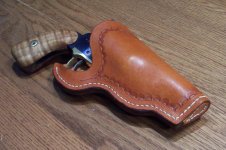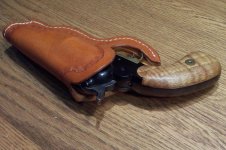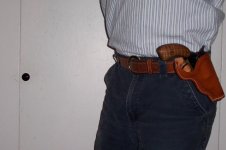I'm making my first full-sized holster - a flap holster for my Luger.
I'm using some dark brown chrome tanned, pre-dyed leather I picked up at the local Tandy store. I've got the pieces all cut out and ready to stitch together, but I have a question or two about finishing the edges.
I figured this would be the best place to pose some questions for our leather-working and holster-making experts.
First question: For the single thickness belt loop on the back, I presume I need to burnish the edges BEFORE stitching it onto the back of the holster?
Second question: I'm thinking that since I will be gluing the edges wherever two layers are sewn together, I'm thinking it will work best to glue and stitch those edges together and then burnish them together AFTERWARDS, right?
Third question: With this chrome-tanned semi-soft leather that is just over 1/8" thick, what is the best & easiest method to burnish the edges?
One technique that I've read about is to apply a clear acrylic paint on the edge and then sand it, repeating the process as many times as necessary to achieve a smooth slick edge. Anyone have another method to suggest that will work better and/or is easier/quicker?
Lobo, Snubby, and all the other leather gurus, I am really in need of your expert opinions. Thanks in advance for any suggestions you care to offer this neophyte.
I'm using some dark brown chrome tanned, pre-dyed leather I picked up at the local Tandy store. I've got the pieces all cut out and ready to stitch together, but I have a question or two about finishing the edges.
I figured this would be the best place to pose some questions for our leather-working and holster-making experts.
First question: For the single thickness belt loop on the back, I presume I need to burnish the edges BEFORE stitching it onto the back of the holster?
Second question: I'm thinking that since I will be gluing the edges wherever two layers are sewn together, I'm thinking it will work best to glue and stitch those edges together and then burnish them together AFTERWARDS, right?
Third question: With this chrome-tanned semi-soft leather that is just over 1/8" thick, what is the best & easiest method to burnish the edges?
One technique that I've read about is to apply a clear acrylic paint on the edge and then sand it, repeating the process as many times as necessary to achieve a smooth slick edge. Anyone have another method to suggest that will work better and/or is easier/quicker?
Lobo, Snubby, and all the other leather gurus, I am really in need of your expert opinions. Thanks in advance for any suggestions you care to offer this neophyte.








